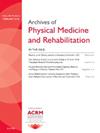Physical Activity Variability in Patellofemoral Pain: Relationships With Clinical and Psychological Outcomes
IF 3.6
2区 医学
Q1 REHABILITATION
Archives of physical medicine and rehabilitation
Pub Date : 2025-06-01
DOI:10.1016/j.apmr.2024.10.008
引用次数: 0
Abstract
Objectives
To (1) compare physical activity variability between individuals with patellofemoral pain (PFP) and pain-free individuals and (2) evaluate the relationships of physical activity variability with pain severity, symptom duration, disability, and pain catastrophizing in PFP cohorts.
Design
Cross-sectional case-control study.
Setting
University research laboratory.
Participants
Individuals with PFP (N=34) and pain-free individuals (N=34) aged 18 to 40 years.
Interventions
Not applicable.
Main outcome measures
We assessed physical activity (daily steps and moderate-to-vigorous physical activity [MVPA]) over a period of 14 consecutive days using a triaxial accelerometer. Variability (coefficient of variation) for daily steps and MVPA was calculated, where higher coefficient of variation values indicate greater physical activity variability. We evaluated pain severity (numeric pain rating scale), symptom duration (months), disability (Knee Injury and Osteoarthritis Outcome Score-Patellofemoral subscale), and pain catastrophizing (Pain Catastrophizing Scale). Independent t tests or Mann–Whitney U tests evaluated group differences in physical activity variability. Spearman ρ correlation coefficients were calculated to determine the relationships of physical activity variability with pain severity, symptom duration, disability, and pain catastrophizing in PFP cohorts. Correlation coefficients were interpreted as weak (<0.40), moderate (0.40-0.70), and strong (>0.70).
Results
Age, height, and mass did not differ between individuals with PFP and pain-free individuals (P>.05). Individuals with PFP displayed greater variability in daily steps (P<.001) and MVPA (P=.001) compared to pain-free individuals. In individuals with PFP, greater variability in daily steps was moderately related to higher pain severity (ρ=0.41, P=.016), while greater variability in MVPA was weakly related to higher pain severity (ρ=0.36, P=.037).
Conclusions
Individuals with PFP demonstrated greater variability in physical activity compared to pain-free individuals, which positively related to more severe pain. Future PFP research should explore the underlying factors contributing to increased physical activity variability and their potential implications for pain management.
髌骨股骨痛的体力活动可变性:与临床和心理结果的关系
目的目的:(1)比较髌骨股骨痛(PFP)患者和无痛患者的体力活动变异性;(2)评估PFP队列中体力活动变异性与疼痛严重程度、症状持续时间、残疾和疼痛灾难化的关系:设计:横断面病例对照研究:地点:大学研究实验室:干预措施:不适用:主要结果测量我们使用三轴加速度计对连续 14 天的体力活动(每日步数和中高强度体力活动 [MVPA])进行了评估。我们计算了每日步数和 MVPA 的变异性(变异系数),CV 值越高,表明体力活动的变异性越大。我们评估了疼痛的严重程度(数字疼痛评分量表)、症状持续时间(月)、残疾程度(膝关节损伤和骨关节炎结果评分-髌股关节分量表)和疼痛灾难化程度(疼痛灾难化量表)。独立 t 检验或 Mann-Whitney U 检验评估了体力活动变异性的组间差异。计算斯皮尔曼 ρ 相关系数以确定体力活动变异性与 PFP 组群中疼痛严重程度、症状持续时间、残疾和疼痛灾难化之间的关系。相关系数被解释为弱(0.70):结果表明:PFP 患者与无痛患者在年龄、身高和体重方面没有差异(P>.05)。PFP患者的每日步数变异性更大(PC结论:PFP患者的每日步数变异性更大(P>.05):与无痛患者相比,PFP 患者的体力活动变异性更大,这与更严重的疼痛呈正相关。未来的 PFP 研究可能会探索导致体力活动变异性增加的潜在因素及其对疼痛管理的潜在影响。
本文章由计算机程序翻译,如有差异,请以英文原文为准。
求助全文
约1分钟内获得全文
求助全文
来源期刊
CiteScore
6.20
自引率
4.70%
发文量
495
审稿时长
38 days
期刊介绍:
The Archives of Physical Medicine and Rehabilitation publishes original, peer-reviewed research and clinical reports on important trends and developments in physical medicine and rehabilitation and related fields. This international journal brings researchers and clinicians authoritative information on the therapeutic utilization of physical, behavioral and pharmaceutical agents in providing comprehensive care for individuals with chronic illness and disabilities.
Archives began publication in 1920, publishes monthly, and is the official journal of the American Congress of Rehabilitation Medicine. Its papers are cited more often than any other rehabilitation journal.

 求助内容:
求助内容: 应助结果提醒方式:
应助结果提醒方式:


